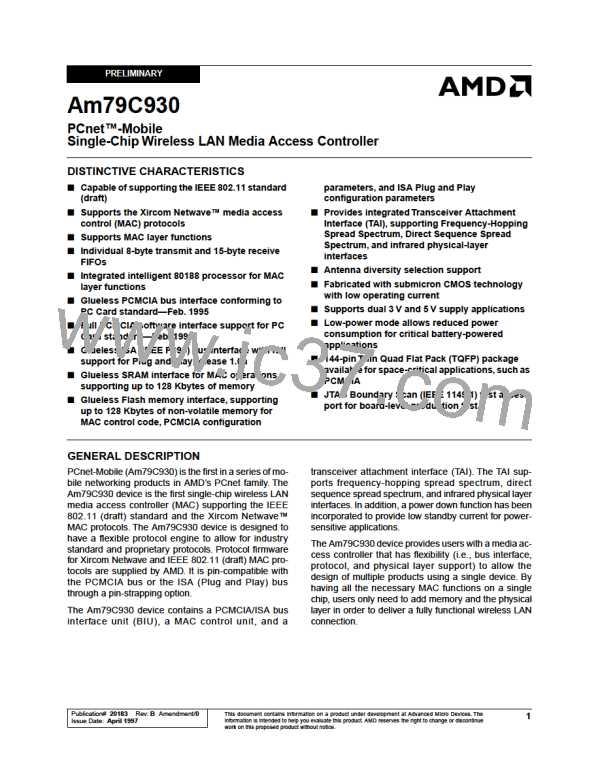AMD
P R E L I M I N A R Y
Following the RESET operation, the Am79C930 firm-
ware or driver software should appropriately program
the D bits of TIR and TCR registers, and then set the FN
and EN bits of TIR and TCR registers to set the values
and directions of each of these programmable pins.
Once these operations have been performed, the soft-
ware should then program the INITDN bit of MIR9 in or-
der to disable all of the pull up and pull down devices.
Unused programmable pins should be programmed for
output mode, or may be left in the default high imped-
ance state if an external pull down or pull up device is left
connected to the pin. Unused programmable pins must
not be programmed for input mode with no external
source (pull-device or driver) connected and the INITDN
bit of MIR9 set to a 1, since this could lead to unaccept-
able levels of power consumption by the Am79C930 de-
vice. For more information on programmable pins, see
the Multi-Function Pins section.
PIN DESCRIPTIONS
Pins with Internal Pull Up or Pull
Down Devices
Several pins of the Am79C930 device include internal
pull up or pull down devices. With the exception of the
RESET pin, these pins are fully programmable as inputs
or outputs when the PCMCIA mode has been selected.
A subset of these pins is programmable when the ISA
Plug and Play mode has been selected. These pins will
come up after RESET in the high impedance state with
the pull up or pull down device actively determining the
value of the pin, unless an external driving source
overdrives the pull up or pull down device. VINITDN
bit (MIR9[2]) is used to turn off all pull up and pull
down devices.
The following list indicates those pins that contain pull
up and pull down devices:
Configuration Pins
PCMCIA
PCMCIA Mode
Pin Name
Internal Device
Type
Size of Internal
Device
PCMCIA/ISA Bus Interface Select
Input
USER[6]/IRQ5
USER[5]/IRQ4
USER[4]/LA17
USER[3]/SA16
USER[2]/LA19
USER[1]/IRQ12
USER[0]/RFRSH
LLOCKE/SA15
ANTSLT/LA23
TXDATA/LA20
TXCMD/LA21
RXC/IRQ10
USER7/IRQ11
LFPE
pull up
pull up
pull up
pull up
pull up
pull down
pull down
pull down
pull up
pull up
pull down
pull up
pull up
pull up
pull up
pull up
pull down
pull up
pull up
pull up
pull up
pull up
pull up
pull up
pull up
pull up
pull up
pull up
pull up
> 100K Ω
> 100K Ω
> 100K Ω
> 100K Ω
> 100K Ω
> 100K Ω
> 100K Ω
> 100K Ω
> 100K Ω
> 100K Ω
> 100K Ω
> 100K Ω
> 100K Ω
> 100K Ω
> 100K Ω
> 100K Ω
> 100K Ω
> 100K Ω
> 100K Ω
> 100K Ω
> 100K Ω
> 100K Ω
> 100K Ω
> 100K Ω
> 100K Ω
> 100K Ω
> 100K Ω
> 100K Ω
> 100K Ω
The value of this pin will asynchronously determine the
operating mode of the Am79C930 device, regardless of
the state of the RESET pin and regardless of the state of
the CLKIN pin. If the PCMCIA pin is tied to VCC, then the
Am79C930 controller will be programmed for PCMCIA
Bus Mode. If the PCMCIA pin is tied to VSS, then the
Am79C930 controller will be programmed for ISA Plug
and Play Bus Interface Mode.
HFPE
RXPE
ANTSLT
TXCMD
TXPE
SDCLK
SDDATA
SDSEL[3]
SDSEL[2]
SDSEL[1]
ACT
LNK
TXMOD
STSCHG/BALE
TXC
Am79C930
25

 AMD [ AMD ]
AMD [ AMD ]